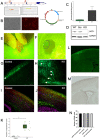This is a preprint.
Loss of Slc35a2 alters development of the mouse cerebral cortex
- PMID: 38077069
- PMCID: PMC10705455
- DOI: 10.1101/2023.11.29.569243
Loss of Slc35a2 alters development of the mouse cerebral cortex
Update in
-
Loss of Slc35a2 alters development of the mouse cerebral cortex.Neurosci Lett. 2024 Jul 27;836:137881. doi: 10.1016/j.neulet.2024.137881. Epub 2024 Jun 22. Neurosci Lett. 2024. PMID: 38909838 Free PMC article.
Abstract
Brain somatic variants in SLC35A2 are associated with clinically drug-resistant epilepsy and developmental brain malformations, including mild malformation of cortical development with oligodendroglial hyperplasia in epilepsy (MOGHE). SLC35A2 encodes a uridine diphosphate galactose translocator that is essential for protein glycosylation; however, the neurodevelopmental mechanisms by which SLC35A2 disruption leads to clinical and histopathological features remain unspecified. We hypothesized that focal knockout (KO) or knockdown (KD) of Slc35a2 in the developing mouse cortex would disrupt cerebral cortical development through altered neuronal migration and cause changes in network excitability. We used in utero electroporation (IUE) to introduce CRISPR/Cas9 and targeted guide RNAs or short-hairpin RNAs to achieve Slc35a2 KO or KD, respectively, during early corticogenesis. Following Slc35a2 KO or KD, we observed disrupted radial migration of transfected neurons evidenced by heterotopic cells located in lower cortical layers and in the sub-cortical white matter. Slc35a2 KO in neurons did not induce changes in oligodendrocyte number, suggesting that the oligodendroglial hyperplasia observed in MOGHE originates from distinct cell autonomous effects. Spontaneous seizures were not observed, but intracranial EEG recordings after focal KO showed a reduced seizure threshold following pentylenetetrazol injection. These results demonstrate that Slc35a2 KO or KD in vivo disrupts corticogenesis through altered neuronal migration.
Keywords: CRISPR; cerebral cortex; cortical dysplasia; glycosylation; short-hairpin RNA.
Conflict of interest statement
Competing Interest Statement The authors have no competing interests to declare.
Figures




References
-
- Kodera H, Nakamura K, Osaka H, et al. De novo mutations in SLC35A2 encoding a UDP-galactose transporter cause early-onset epileptic encephalopathy. Hum Mutat. 2013. Dec;34(12):1708–14. - PubMed
-
- Blumcke I, Aronica E, Miyata H, et al. International recommendation for a comprehensive neuropathologic workup of epilepsy surgery brain tissue: A consensus Task Force report from the ILAE Commission on Diagnostic Methods. Epilepsia. 2016. Mar;57(3):348–58. - PubMed
Publication types
Grants and funding
LinkOut - more resources
Full Text Sources
Research Materials
